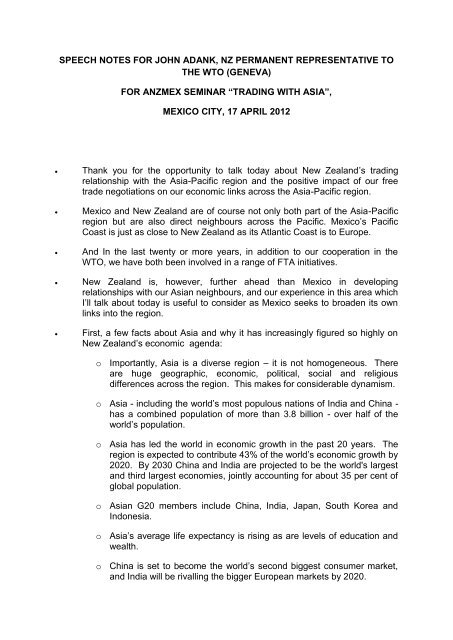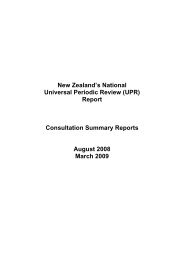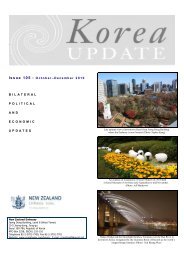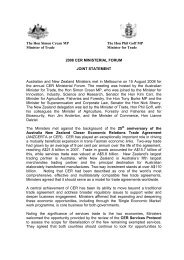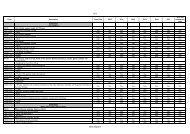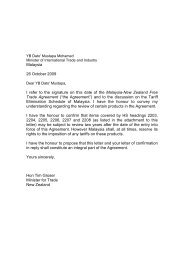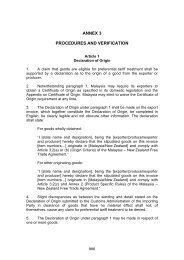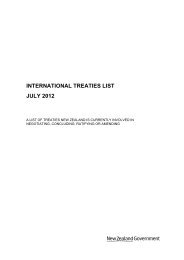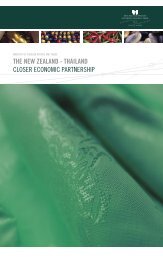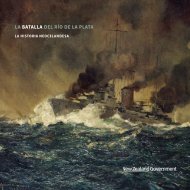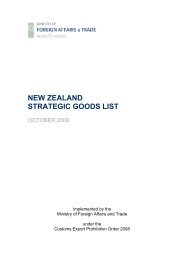Speech by John Adank, NZ
Speech by John Adank, NZ
Speech by John Adank, NZ
You also want an ePaper? Increase the reach of your titles
YUMPU automatically turns print PDFs into web optimized ePapers that Google loves.
SPEECH NOTES FOR JOHN ADANK, <strong>NZ</strong> PERMANENT REPRESENTATIVE TO<br />
THE WTO (GENEVA)<br />
FOR A<strong>NZ</strong>MEX SEMINAR “TRADING WITH ASIA”,<br />
MEXICO CITY, 17 APRIL 2012<br />
� Thank you for the opportunity to talk today about New Zealand’s trading<br />
relationship with the Asia-Pacific region and the positive impact of our free<br />
trade negotiations on our economic links across the Asia-Pacific region.<br />
� Mexico and New Zealand are of course not only both part of the Asia-Pacific<br />
region but are also direct neighbours across the Pacific. Mexico’s Pacific<br />
Coast is just as close to New Zealand as its Atlantic Coast is to Europe.<br />
� And In the last twenty or more years, in addition to our cooperation in the<br />
WTO, we have both been involved in a range of FTA initiatives.<br />
� New Zealand is, however, further ahead than Mexico in developing<br />
relationships with our Asian neighbours, and our experience in this area which<br />
I’ll talk about today is useful to consider as Mexico seeks to broaden its own<br />
links into the region.<br />
� First, a few facts about Asia and why it has increasingly figured so highly on<br />
New Zealand’s economic agenda:<br />
o Importantly, Asia is a diverse region – it is not homogeneous. There<br />
are huge geographic, economic, political, social and religious<br />
differences across the region. This makes for considerable dynamism.<br />
o Asia - including the world’s most populous nations of India and China -<br />
has a combined population of more than 3.8 billion - over half of the<br />
world’s population.<br />
o Asia has led the world in economic growth in the past 20 years. The<br />
region is expected to contribute 43% of the world’s economic growth <strong>by</strong><br />
2020. By 2030 China and India are projected to be the world's largest<br />
and third largest economies, jointly accounting for about 35 per cent of<br />
global population.<br />
o Asian G20 members include China, India, Japan, South Korea and<br />
Indonesia.<br />
o Asia’s average life expectancy is rising as are levels of education and<br />
wealth.<br />
o China is set to become the world’s second biggest consumer market,<br />
and India will be rivalling the bigger European markets <strong>by</strong> 2020.
o Asia’s vast and increasingly wealthy customer base is shaping the<br />
region into a centre of innovation and influence upon consumer trends.<br />
� This is why Asia is fundamentally important to <strong>NZ</strong>’s economic wellbeing. Asia<br />
accounted for more than 41% of our total two-way trade in the 2009 calendar<br />
year. Six of our current top 10 trading partners are in Asia. In sum, Asia<br />
looms very large on <strong>NZ</strong>’s horizon strategically, economically, socially, and<br />
culturally. And I should just note here that based on recent survey findings,<br />
<strong>NZ</strong>ers seem to be increasingly conscious of just how important Asia is to our<br />
future prosperity. This includes a finding that 4 out of 5 <strong>NZ</strong>ers believe that<br />
Asian migrants contribute significantly to the country and bring valuable<br />
cultural diversity.<br />
� Yet for many decades <strong>NZ</strong>’s geographical location on the rim of the Asia-<br />
Pacific region was seen as a major strategic disadvantage. Particularly in<br />
this 21st century, it has become a major strategic advantage. For example,<br />
New Zealand is located halfway between Latin America and Asia and can<br />
provide a useful gateway into the Asian market for some Latin American<br />
businesses, as well as travellers.<br />
� Let me now explain how New Zealand has strategically sought to create a<br />
template for Asia Pacific trade and investment integration over the last ten<br />
years. And to tell you about some of the results of that vision.<br />
A<strong>NZ</strong> Trade integration<br />
� The beginning of this story starts with Australia. <strong>NZ</strong>’s closest and broadest<br />
trading relationship is naturally with Australia. These days we take this for<br />
granted. But it’s important to remind ourselves of just how long it took for the<br />
two Trans-Tasman neighbours to recognise the value of free trade.<br />
� Some of you might be surprised to hear that the first ever trade agreement<br />
utilising the NAFTA acronym was in fact the “New Zealand Australia Free<br />
trade Agreement” concluded in 1965, at a time when <strong>NZ</strong> in trade terms was<br />
very much Britain’s farm in the South Pacific.<br />
� This antipodean NAFTA was an attempt to promote diversification of our trade<br />
profile. Sadly, it was not a great success, having only a modest impact on<br />
trade given the highly complex and only limited trade liberalising aspects of<br />
the agreement.<br />
� But we learned a number of lessons from this, and the subsequent A<strong>NZ</strong><br />
Closer Economic Relations Agreement (CER) concluded in 1983 has<br />
proved to be a stellar success. At the time of signature it was considered the<br />
most comprehensive economic partnership agreement in the world. Free<br />
trade in goods between Australia and New Zealand was achieved in 1990 and<br />
we are now working towards the long term vision of creating a seamless<br />
trans-Tasman economy – known as the Single Economic Market agenda. The<br />
success of CER has served to reinforce New Zealand’s commitment to high<br />
quality, comprehensive free trade agreements and win/win scenarios.
� The closer integration of the A<strong>NZ</strong> economies was an important pre-requisite<br />
to the wider A<strong>NZ</strong> push into Asia. This took some time to commence,<br />
however, and for over a decade and a half after the conclusion of CER neither<br />
we nor Australia concluded substantive FTAs with Asian countries. During<br />
this period of course Mexico was very much preoccupied with the FTA<br />
arrangements in its own immediate neighbourhood under NAFTA. So we had<br />
to play catch-up.<br />
A<strong>NZ</strong> Integration with ASEAN<br />
� But we eventually began this process. And the beginning of all of this was the<br />
decision taken <strong>by</strong> Singapore and New Zealand to negotiate an FTA – called a<br />
Closer Economic partnership - which was concluded in 2001. It’s fair to say<br />
that some wondered at the time what was the point of this given that both <strong>NZ</strong><br />
and Singapore were very open economies with very few real trade barriers.<br />
� But the strategic significant of this initiative should not be underestimated. For<br />
it provided the first step in what would eventually see the deeper integration of<br />
the A<strong>NZ</strong> CER relationship with ASEAN through the conclusion of a number of<br />
additional bilateral and plurilateral agreements involving ASEAN members.<br />
This includes in <strong>NZ</strong>’s case not only bilateral agreements with Thailand (2004)<br />
and Malaysia (2010) but also the Pacific-4 Agreement involving <strong>NZ</strong>, Brunei,<br />
Singapore as well as Chile (2005).<br />
� The most concrete manifestation of CER/ASEAN trade integration is the<br />
ASEAN-Australia-<strong>NZ</strong>-FTA (AA<strong>NZ</strong>FTA) concluded in 2010. This<br />
Agreement extends the original building block of the CER with Australia to<br />
include the 10 economies in South East Asia (ASEAN).<br />
� Collectively, ASEAN is now <strong>NZ</strong>'s third-largest export market for merchandise<br />
goods; one in every eight export dollars is earned in ASEAN; one in five of<br />
New Zealand dairy export dollars earned is in ASEAN. And this is going to<br />
get better as the FTA means within 12 years 99% of <strong>NZ</strong>'s current trade with<br />
Indonesia, Malaysia, the Philippines and Viet Nam will be duty free.<br />
� For <strong>NZ</strong> businesses operating in these markets this is a major advancement in<br />
terms of their market access into these major and growing markets. But<br />
AA<strong>NZ</strong>FTA does more than simply address tariff lines for merchandise trade.<br />
One of its key strengths is its comprehensiveness, in that it covers services,<br />
investment and other areas.<br />
� AA<strong>NZ</strong>FTA is now firmly established as one of the key building blocks for the<br />
promotion of closer regional economic integration.<br />
� But there are a number of other initiatives that <strong>NZ</strong> has pursued with other key<br />
Asian economies well beyond our cooperation with ASEAN.<br />
<strong>NZ</strong>/China FTA
� The New Zealand-China FTA has been a great success for both parties.<br />
Here are just a few examples of what having an FTA with China has meant for<br />
New Zealand:<br />
o Since the FTA entered into force in October 2008, New Zealand’s trade<br />
with China has increased <strong>by</strong> more than 50 per cent.<br />
o China is New Zealand’s second largest trading partner (<strong>NZ</strong>$12.9<br />
billion) and in 2011 became our largest source of imports – overtaking<br />
Australia for the first time. Exports have tripled in the three years since<br />
the China FTA entered into force in October 2008.<br />
o Total merchandise trade with China is growing faster than for any of<br />
our other major trading partners and is on track to double to <strong>NZ</strong>$20<br />
billion <strong>by</strong> 2015.<br />
o We now trade with China in less than five hours what we traded with<br />
China in a year back in 1972 when New Zealand established<br />
diplomatic relations with China.<br />
o Growth in trade with China has helped <strong>NZ</strong> offset the worst effects of<br />
the global economic recession.<br />
� The FTA is an excellent example of a high quality, 21st century agreement.<br />
Our two-year review of the FTA reiterated its relevance to both economies<br />
and our commitment to continual improvement in our bilateral trade<br />
structures.<br />
� It is complemented <strong>by</strong> a genuine Closer Economic Partnership between<br />
New Zealand and Hong Kong which was signed in March 2010.<br />
� Although China is New Zealand’s 2 nd largest trading partner, we are only<br />
China’s 52 nd trading partner. But China recognises <strong>NZ</strong> for the so-called “Four<br />
Firsts”. New Zealand was the first nation to support China's accession to the<br />
WTO; the first to formally recognize China as a market economy; and the first<br />
to commence, then complete, free trade negotiations with China. <strong>NZ</strong>’s<br />
willingness to be a pioneer in these areas has been clearly appreciated <strong>by</strong><br />
China and contributed to the considerable goodwill at the heart of the trade<br />
relationship.<br />
Our Longer Term Vision<br />
� The Agreements concluded to date represent in our view important building<br />
blocks towards our longer term vision which is to address the complex<br />
network of free trade agreements spanning the Asia-Pacific – the so-called<br />
“noodle bowl” of overlapping and sometimes contradictory regimes.<br />
� New Zealand and Mexico work together in APEC – and this network has done<br />
some valuable work in untangling the noodle bowl. In fact it was APEC<br />
leaders that first endorsed the long term goal of a Free Trade Area for the<br />
Asia Pacific.
� There are also other integration proposals in the Asia region. The East Asia<br />
Summit has agreed to look at the prospects for a Comprehensive Economic<br />
Partnership in East Asia (CEPEA) – the ASEAN + 6 which would involve the<br />
ten ASEAN countries, plus the three north Asian economies of China, Korea<br />
and Japan, as well as Australia, New Zealand and India.<br />
� These are bold concepts which are proceeding steadily and incrementally,<br />
through technical work, although no political decisions have yet been taken<br />
on how to translate these concepts into a mandate for an actual trade<br />
negotiation.<br />
� These efforts are all important responses to the realities of global and regional<br />
trade and investment patterns. There is a sense that each of our economies<br />
needs to move forward on the trade agenda where it can, especially given<br />
that we are stuck at the WTO level.<br />
� For all of these reasons New Zealand is an enthusiastic supporter of the<br />
various regional economic integration initiatives under way. Importantly, we<br />
see these as complementary - as potential pathways towards the same<br />
ultimate strategic objective of free trade across the Asia Pacific region.<br />
TPP<br />
� And that brings me to – the Trans Pacific Partnership – which I know, now,<br />
is a key focus for Mexico.<br />
� When the Pacific 4 negotiations (between Chile, New Zealand, Brunei and<br />
Singapore) finished in 2005, its parties agreed to begin negotiating on<br />
financial services and investment within two years of its entry into force. This<br />
P-4 Agreement was a significant one again strategically, as it encompassed<br />
countries from within CER, ASEAN and Latin America.<br />
� It opened people’s minds up to a vision of a broader based negotiation from<br />
across these sub regions and into others. Hence, soon after the revised P-4<br />
negotiations began in 2008 the United States announced it wanted to<br />
participate fully in the negotiations, and Australia, Peru, and Viet Nam<br />
followed suit. And this gave birth to the TPP process.<br />
� In November 2009, President Barack Obama said that the United States<br />
would engage with TPP countries "with the goal of shaping a regional<br />
agreement that will have broad-based membership and the high standards<br />
worthy of a 21st century trade agreement".<br />
� Negotiations for an expanded agreement began in March 2010 and later that<br />
year Malaysia joined the negotiations. TPP now involves a total of nine<br />
APEC economies.<br />
� At the APEC Leaders’ Meeting in Honolulu last November, the nine APEC<br />
members involved in TPP were able to take some important decisions to<br />
consolidate politically the TPP negotiations.
� Trade Ministers defined the broad outlines of a deal and this was endorsed <strong>by</strong><br />
Leaders. It represents the base from which the negotiations will proceed.<br />
� There is a lot of difficult work still to do in order to overcome the sensitivities in<br />
the negotiation, but the broad outlines agreed in Honolulu are an important<br />
milestone in that process.<br />
� As we enter this more intensive phase of the negotiations, every participating<br />
economy has committed to delivering a high quality, comprehensive outcome<br />
in TPP.<br />
� At the Honolulu meeting, Leaders also directed negotiators to finalise the TPP<br />
agreement this year. That is an ambitious timetable, but nonetheless one to<br />
which the group is working to deliver on.<br />
� The eleventh negotiating round took place in March in Melbourne, Australia.<br />
Subsequent rounds will be held at six to eight week intervals during the year.<br />
Many of the individual working groups have also been meeting<br />
intersessionally in order to maintain the momentum.<br />
� While we are aiming for a 21 st century trade agreement – there remain some<br />
outstanding issues from the 2oth century trade agenda. It is important to<br />
appreciate therefore the commitment in the TPP Trade Ministers’ Report<br />
(endorsed <strong>by</strong> Leaders in Honolulu) to eliminate tariffs and other barriers to<br />
trade, with the goal of “comprehensive duty free access to each other’s goods<br />
markets”.<br />
� All of the TPP negotiators understand that this will not be easy. This is the<br />
political challenge facing TPP members. WTO-consistent transitional<br />
arrangements will be necessary.<br />
� With respect to the sensitive agriculture sector, it may well take a decade to<br />
allow for gradual and progressive liberalisation. But “elimination” of tariffs is<br />
the aim.<br />
� I wanted to comment here on New Zealand’s dairy objectives in the TPP and<br />
related contexts, which we know is a topic of interest to the agriculture sector<br />
here in Mexico.<br />
� There are a number of realities about this which are not well understood:<br />
New Zealand is a small producer of dairy products. We produce only 2.5 per<br />
cent of world milk, which is equivalent to the same amount that the Indian<br />
state of Uttar Pradesh produces. There is scope to increase production. Our<br />
exports could therefore increase <strong>by</strong> around 2-3 per cent per annum. Based<br />
on these projections, New Zealand could produce another 4 to 7 million<br />
tonnes of wholemilk equivalent <strong>by</strong> 2025.<br />
� But that increase in production is far outstripped <strong>by</strong> the projected growth in<br />
demand for milk – especially from the likes of China and India. New Zealand<br />
will not be flooding TPP dairy markets. There is a great future for all dairy
producers. (And New Zealand has a lot of technological expertise to share in<br />
this sector. We have a long history of agri-business innovation).<br />
� Returning to the ambition of TPP, the TPP Trade Ministers Report commits<br />
each TPP member to establishing a single schedule – a technical term used<br />
to describe legal commitments to open markets to imports – for all the other<br />
TPP partner countries.<br />
� The report also states there will be common rules of origin in TPP that will<br />
make it easier for businesses to take advantage of the agreement as well as<br />
encourage the use of TPP inputs.<br />
� Recent OECD research has shown that 56 per cent of overall goods trade<br />
flows are in intermediate products, i.e. parts or components that are traded<br />
across national borders before becoming part of a final traded product. (A<br />
recent report on US/Mexico trade under NAFTA illustrates this point. The<br />
study, entitled Working Together: Economic Ties between the US and Mexico,<br />
<strong>by</strong> Christopher E Wilson of the Woodrow Wilson International Center for<br />
Scholars, informs us that a full 40% of the content of US imports from Mexico<br />
is actually produced in the United States)<br />
The new nature of trade – Global and Regional Supply Chains<br />
� To be globally competitive, businesses need to lower operating costs and to<br />
be close to their markets and customers. The old concept of selling vertically<br />
integrated products manufactured in one country is outdated. There are huge<br />
productivity gains from this intra-industry trade leading to global supply chains<br />
which now dominate world trade.<br />
� We already have examples of New Zealand firms setting up plants in Mexico<br />
for this very reason, and I’m sure there will be more in the future. Two<br />
companies, Fisher and Paykel Healthcare and Fisher and Paykel Appliances,<br />
have established factories in the north of Mexico, which sell primarily to the<br />
US market. Another company, Avohealth, is currently establishing a plant in<br />
Jalisco, with a Mexican partner, to produce avocado oil for export.<br />
� This increased economic interdependency and complex production and<br />
distribution patterns requires clear and coherent rules for trade and<br />
investment. The TPP negotiation is addressing this challenge.<br />
� This includes examining “behind the border” issues such as regulatory and<br />
non-tariff barriers that pose major hurdles for businesses in the 21 st century.<br />
� Maintaining and enforcing this complex array of regulations is costly and<br />
resource-consuming and increasingly there is a need to harmonise standards<br />
and regulatory requirements to facilitate trade.
� This should allow businesses to operate in a competitive, innovative<br />
environment with low compliance costs. This is a key objective for TPP.<br />
Mexico’s interest in TPP<br />
� So that is the TPP story so far, and what I hope it illustrates is how TPP did<br />
not just happen overnight but evolved from a range of earlier “building block”<br />
initiatives that New Zealand negotiators and other partners have pursued<br />
doggedly over the last ten years.<br />
� But a discussion of TPP here today would of course not be complete without<br />
noting also the interest expressed <strong>by</strong> Mexico in joining TPP which New<br />
Zealand has welcomed.<br />
� Mexico – as well as Japan and Canada – have begun the process of<br />
engaging with the TPP members. It is not a straightforward process. Any<br />
decision on new members will need to be made <strong>by</strong> Ministerial consensus<br />
among the nine members of TPP. Before that, each of the three interested<br />
countries needs to complete a process of bilateral consultations with each of<br />
the nine current TPP members.<br />
� For New Zealand’s part, we have told each of the three that we are keen to<br />
ensure that any expansion of membership does not result in a dilution of the<br />
high quality objectives expressed <strong>by</strong> TPP Leaders and Trade Ministers at<br />
APEC. Essentially any new member needs to commit to that vision.<br />
� This is especially important in reference to comprehensive market access<br />
through the elimination of tariffs and other non-tariff barriers to trade in goods<br />
and services. We will need to see clear commitment in this respect.<br />
� We are also keen to ensure that there is no slow-down in the pace of<br />
negotiations.<br />
� New Zealand stakeholders have been consulted about expanding the<br />
membership of TPP and agree with this. Companies trading with Mexico,<br />
Canada and Japan highlighted the advantages to their trade and economic<br />
objectives of bringing those partners into the negotiations, provided that there<br />
is no dilution of the current ambition as regards scope and timeline for the<br />
negotiations.<br />
� As regards Mexico specifically, our two countries have both long been<br />
committed to seeking ways of promoting greater trade and economic links,<br />
and indeed there has been progress over the years in increasing our<br />
economic relationship: but there is potential for much more.<br />
� Our economies are complementary and, as I’ve pointed out, we’re both<br />
partners in the broader Asia-Pacific community. Both governments have in the
Conclusion<br />
past carried out studies on the feasibility of a bilateral FTA, but current<br />
regional dynamics and particularly the evolution of the TPP point to another<br />
route that, sooner or later, will bring our economies closer together and<br />
enhance opportunities for both of us.<br />
� In conclusion, I have outlined the evolution of a model for economic<br />
integration across the Asia Pacific, culminating in the current TPP negotiation.<br />
This is an ambitious undertaking – both in terms of content and pace – and<br />
will, no doubt, require some hard political and economic challenges as<br />
regional integration advances. Mexico remains a key partner in the<br />
Asia/Pacific and we are keen to deepen our conversation with Mexico on how<br />
we can expand cooperation across our shared neighbourhood.


